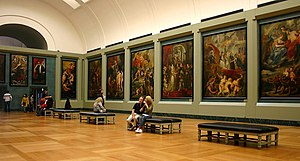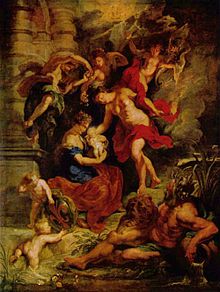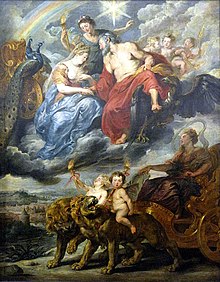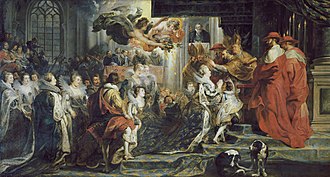Marie de' Medici cycle
[8] In 1621, Marie de' Medici commissioned Rubens to paint two large series depicting the lives of herself and her late husband, Henry IV, to adorn both wings of the first floor of the Luxembourg Palace.
[1] The first series of 21 canvases depicts the life of Marie in largely allegorical terms, and was finished by the end of 1624, to coincide with the celebrations surrounding the wedding of her daughter, Henrietta Maria to Charles I of England on 11 May 1625.
[12] Far from failing, Rubens demonstrated his impressive knowledge of classical literature and artistic traditions,[13] by using allegorical representations to both glorify the mundane aspects and sensitively illustrate the less favorable events in Marie's life.
[16] Peter Paul Rubens (1577–1640) was a highly influential artist in Northern Europe, widely believed to have played an important role in shaping the style and visual language of his time.
Originally the paintings were hung clockwise in chronological order, decorating the walls of a waiting room expanding from a royal apartment in Marie de' Medici's Luxembourg Palace.
Within this context Rubens' approach to 'historical truth' may appear selective or, worse, dishonest, but he was neither a historian in the modern sense, nor a journalist; the Medici cycle is not reportage, but rather poetic transformation.
As was often the case with royal weddings, the bride's uncle, Ferdinando I de' Medici, Grand Duke of Tuscany stood in the King's place and is pictured here slipping a ring on his niece's finger.
Although he was present at the actual event twenty years earlier, as a member of the Gonzaga household during his travels in Italy, Rubens appears youthful and stands behind the bride, holding a cross and gazing out at the viewer.
As in other scenes in the Medici Cycle, Rubens includes a mythological element: the ancient god of marriage, Hymenaios wearing a crown of roses, carries the bride's train in one hand and the nuptial torch in the other.
[48] The scene takes place below a marble statue, which depicts God the Father mourning over the dead body of Christ, alluding to the Pieta sculpture by Baccio Bandinelli (1493–1560).
Having never been a particularly graceful event for anyone, disembarking a ship does not pose a problem for Rubens in his depiction of Marie de' Medici arriving in Marseilles after having been married to Henry IV by proxy in Florence.
Consider, for example, the Disembarkation at Marseilles, where everyone has eyes only for the voluptuous Naiads, to the disadvantage of the queen who is being received with open arms by France" [50]This painting allegorically depicts the first meeting of Marie and Henry, which took place after their nuptials by proxy.
[55] Rubens incorporates the traditional allegory of the cornucopia, which symbolizes abundance, to enhance the meaning of the painting by including the heads of Marie de' Medici's children who have yet to be born among the fruit.
Considered one of the principal paintings in the series along with The Death of Henry IV and the Proclamation of the Regency both scenes also show Marie de' Medici receiving the orb of state.
The crowd below in the basilica raise their hands in acclamation of the new Queen, and above, the classical personifications of Abundantia and a winged Victoria shower the blessings of peace and prosperity upon the head of Marie by pouring the golden coins of Jupiter.
Rubens inspiration for the blue coronation orb emblazoned with golden lilies was Guillaume Dupres’ presentation medal struck in 1610 at Marie's’ request portraying her as Minerva with Louis XIII as Apollo-Sol .
[64] The other two having similar design measurements, it was consigned as the middle painting in a pseudo triptych of sorts as it adorned the halls of Marie de' Medici's Palais du Luxembourg.
[68] It should be kept in mind that Rubens' energetic manner of placing all these allegorical themes is substantially resultant from classical coins as documented through communication with his friend and notable collector of antiquities, Nicolas-Claude Fabri de Peiresc.
Although originally started but may or may not have been finished in Rome, Caravaggio's Madonna of the Rosary may well have been an artistic influence on Rubens for the Proclamation of the Regency side of this painting, as the two works are highly corresponding in their presentation.
The mythological figures include Apollo and Pallas, who combat and overcome vices such as Discord, Hate, Fury, and Envy on the ground and Neptune, Pluto, Saturn, Hermes, Pan, Flora, Hebe, Pomono, Venus, Mars, Zeus, Hera, Cupid, and Diana above.
[79] In the painting Marie de' Medici is highly decorated and triumphant after the collapse of a city, she is depicted across a white stallion to demonstrate that, like the departed King Henry IV, she could triumph over rivals in warfare.
[85]) These personifications are accompanied in turn by several allegorical figures in the guise of four putti and three vanquished evil creatures (Envy, Ignorance, and Vice)[85] as well as a number of other symbols that Rubens employed throughout the entire cycle of paintings.
"[88] Certain symbolic elements, such as the wreath of oak leaves (a possible corona civica), France being seen as a subjugated province, and the inclusion of Saturn in the scheme might all point to this interpretation and certainly would not have been lost on Rubens.
It reads, I believe I wrote you that a picture was removed which depicted the Queen's departure from Paris and that, in its place, I did an entirely new one which shows the flowing of the Kingdom of France, with the revival of the sciences and the arts through the liberality and the splendour of Her Majesty, who sits upon a shining throne and holds a scale in her hands, keeping the world in equilibrium by her prudence and equity.
[90] It is believed that the original painting mentioned in the letter depicting Marie's departure from Paris was rejected in favor of The Felicity of the Regency due to the more innocuous subject matter of the latter.
[95] In The Negotiations at Angoulême, Marie de' Medici genially takes the olive branch from Mercury, the messenger god, in the presence of both of her priests, as she gives her consent to have discussions with her son concerning her clash to his governmental direction.
Enthroned on a pedestal with sculptures of Minerva's symbols of wisdom and two putti holding a laurel wreath to represent victory and martyrdom, the representation of Marie de' Medici is quite clear.
All of these symbols, Rubens displayed in this ambiguous and enigmatic painting to represent or "misrepresent" Marie de' Medici in the manner that portrayed her as the prudent, yet caring and humble mother of a young and naïve monarch.
[102] The death in 1621 of the falconer turned supreme commander may have improved the tensions between mother and son, but Henri II, Prince of Condé, considered the most dangerous of Marie de' Medici's foes quickly stepped in to fill the gap.
[104] The artist chose the high road, relying on Ripa's visual vernacular, to portray a scene where virtues defeat vices and embrace peaceful reconciliation making little more than an allusion to a vague political statement.
























